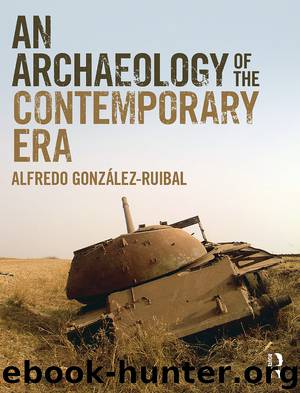An Archaeology of the Contemporary Era by Alfredo Gonzalez-Ruibal;

Author:Alfredo Gonzalez-Ruibal;
Language: eng
Format: epub
Publisher: Taylor & Francis (CAM)
Published: 2018-12-03T16:00:00+00:00
6 Time
THE FINAL THREE chapters of this book will be devoted to the temporal, spatial and material excess of supermodernity.1 Time excess can be said to comprise all the rest because, as Agamben has argued:
Every culture is first and foremost a particular experience of time, and no new culture is possible without an alteration in this experience. The original task of a genuine revolution, therefore, is never merely to “change the world”, but also—and above all—to “change time”.
(Agamben 1993: 91)
The main characteristic of the new time of modernity, and particularly supermodernity, is velocity: “the history of capitalism”, writes David Harvey (1989: 240), “has been characterised by speed-up in the pace of life, while so overcoming spatial barriers that the world sometimes seems to collapse inwards upon us.” Yet the problem is not simply that time is accelerated. As Jean Améry remarked (see Chapter 4), it is also twisted. “The time is out of joint”, agrees Jacques Derrida, quoting Hamlet’s words: “Time is disarticulated, dislocated, dislodged, time is run down, on the run and run down, deranged, both out of order and mad. Time is off its hinges, time is off course, beside itself, disadjusted” (Derrida 2006: 20). This is perhaps a more eloquent way of describing the state of time in supermodernity than the usual idea of “quick time” or time-space compression (Virilio 1986; Harvey 1989; Augé 2002 [1992]; Sewell 2008). Because it is not only that things go faster or that there is a factual excess. It is also, more precisely, that time is out of joint, which is also saying that time is both unjust and anachronistic (Derrida 2006: 25). The philosopher, then, links temporality and morality, both of which are put into crisis by our era. It is probably this feeling that has led archaeologists to focus on alternative, heterogeneous and non-linear temporalities (Witmore 2007b; Olivier 2008; Hamilakis 2011), which are also a matter of concern in other fields (De Landa 1997). In fact, the contemporary era is one of multiple temporalities (Dawdy 2016) which are progressively being erased and uniformised. Homogenisation, however, is yet far from achieved. In this chapter, I will characterise the time of supermodernity through its archaeological traces. For that, I will explore four phenomena: presentism, time annihilation, acceleration and heterochrony. The chapter will end with a reflection on the nature of the temporality of contemporary archaeology and how it can be used to produce richer and more effective accounts of the recent past.
Download
This site does not store any files on its server. We only index and link to content provided by other sites. Please contact the content providers to delete copyright contents if any and email us, we'll remove relevant links or contents immediately.
| Anthropology | Archaeology |
| Philosophy | Politics & Government |
| Social Sciences | Sociology |
| Women's Studies |
Mysteries by Colin Wilson(3294)
People of the Earth: An Introduction to World Prehistory by Dr. Brian Fagan & Nadia Durrani(2644)
Ancient Worlds by Michael Scott(2537)
Foreign Devils on the Silk Road: The Search for the Lost Treasures of Central Asia by Peter Hopkirk(2396)
The Memory Code by Lynne Kelly(2299)
The Splendid and the Vile by Erik Larson(2252)
Lost Technologies of Ancient Egypt by Christopher Dunn(2146)
The Earth Chronicles Handbook by Zecharia Sitchin(2123)
Come, Tell Me How You Live by Mallowan Agatha Christie(2051)
The Plantagenets by Dan Jones(1946)
Last Chance to See by Douglas Adams(1859)
The Return of the Gods by Erich von Daniken(1854)
Wars of the Anunnaki by Chris H. Hardy(1642)
Keeper of Genesis by Graham Hancock(1551)
Before the Dawn by Nicholas Wade(1541)
The Cygnus Mystery by Andrew Collins(1481)
The Message of the Sphinx by Graham Hancock(1447)
Fragile Lives by Stephen Westaby(1380)
Hieroglyphs: A Very Short Introduction by Penelope Wilson(1281)
